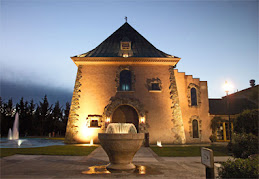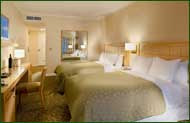Day 1
On the first day of the trek, we were picked up at 4:30 AM for a one and a half hour ride through a darkened Peruvian landscape to the town of Ollantaytambo in the Sacred Valley. Here we stopped for breakfast and to purchase any last supplies needed. After another 30 minute bus ride on a narrow dirt road, we reached our starting point. By 9 AM we had crossed through the government control check that limits trail hikers, including porters and guides, to 500 people each day. As clean, happy tourists, we posed for an enthusiastic photo at the beginning of our trek. Then we crossed the turbulent rapids of the Urambamba River on a rickety wooden bridge to start our journey in the footsteps of the Incas.
While we had been promised a morning of “Peruvian Flat” (i.e. rolling hills) the first hours of our hike seemed mostly uphill to me. My guidebook tells me that these first hours were spent in a sub-tropical ecosystem. The day was warm, and the land was more arid than I had imagined. I was surprised at the number of people living along the trail. Men walked the path with their llamas or donkeys, and children ran along the path watching the tourists. One group of children was even pretending to be tourists themselves. Apparently because it was summer in South America, the children were on their summer break. I’m not sure how much elevation we gained during the morning, but we were definitely going up.
In the morning we saw our first Inca ruins. Below us on the trail was the Inca storehouse of Llacapata. Grains and fruits from the sacred valley were brought here and stored for later distribution to settlements in the mountains.
We stopped for lunch at a campground called Wayllanbaba. Our guide told us that many groups took a short first day on the trail, and stopped here to camp for the night. By lunch, I wished we could stop for the night, but I would soon be grateful that we persevered. Because we went further than most groups did each day, I felt more isolated on the trail. I felt more a part of the beautiful Peruvian wilderness and the spectacular history of the trail than a tourist on a path well-traveled.
After lunch we faced stairs and more stairs as we gained 600 meters of elevation. The steep parts of the trail were lined with stone steps. I imagine that centuries ago these steps were smooth and level. With the passing of time however, the stones have become separated and uneven, making the trek more challenging than it may have been originally. At this higher elevation, the landscape became more tropical, and we entered a dense forest. Because the steep and winding path was surrounded by trees, it was impossible to see far ahead at the endless number of stone stairs to come. I was taken by surprise at a heard of llamas that came running down the path towards me, and quickly backed aside to let them pass.
Exhausted, I reached the first campsite at around 5:30 PM. My reward was a beautiful view of the Sacred Valley during and surrounding mountains during the remaining daylight. Our amazing chef prepared a delicious dinner for us, and food had never tasted so good to me. From the campground, I could hear rushing water from a nearby waterfall, and this was the sound that eventually lulled me to sleep.
Day 2
On the morning of our second day, we faced another 600 meter elevation gain. The upside of all this climbing was spectacular views. Fog covered the valley in the morning. The trees were sparse during this part of the trek and each time I stopped for air, I could admire a spectacular view of mountains and valleys. The morning was hot and sunny, but shrubs provided some shade during water breaks.
Finally after approximately 2 hours of hiking, I reached the top of the trek’s highest pass. At 4,200 meters, it was hard to believe how far we had already come. My sense of victory was short-lived, however, as we spent the next few hours descending. All of that hard working climbing up seemed for nothing! The back-side of the mountain seemed like it received more rain, as there was more foliage and flowers. My favorite flowers were the lupines, clusters of small purple and white petals in a conical shape. Our very knowledgeable guide, Sol, also pointed out baby Falcons flying nearby.
After lunch we began climbing again. Half-way through our ascent we reached the ruins of Runkuraqay, which was a guard tower. From it we could see two ancient Inca trails, the one we were hiking and another, now overgrown. This strategic location also had a view of the pass on which we had recently stood. I could see the shadows of other hikers who had recently summitted.
We continued along the path to climb to the second-highest elevation of our hike at 3950 meters. We passed serene mountain lakes on our way up, and by then it was all I could do to keep from jumping in! The steep descent seemed even harder than the ascent. Descending on the uneven stone steps took great concentration and strength. Our guide, Sol, called this “meditation time” for internal contemplation. I saw even more flowers during this part of the hike, including the beautiful yellow lady slippers and the blue purple potato flowers.
Late in the day we reached, Sayamarka, which means “Inaccessible Place” in Quechua. To get to these ruins we climbed terrifyingly steep steps with no protection from falling off a cliff and into the forest below. This mountain community was a resting spot for travelers to Machu Picchu. Fog swirled around the neighboring mountains, adding to an air of mystery. Our guide showed us how water was channeled from nearby mountain springs to the complex of buildings and then circled around to provide water to all inhabitants.
During our final half hour of hiking we entered the cloud forest. Finally we reached our camp, which had views of snow-capped mountains. We celebrated our victory over the two challenging mountain passes with mad-libs and drinking games. But after we retired to our tents, a storm set in. Thunder and lightning kept waking me up each time I managed to fall asleep.
Day 3
On day 3, I finally found the “Peruvian Flat” I was promised on Day 1. We had only 100 meters of uphill climb, followed my mostly flat land or rolling hills. The cloud forest reminded me of those I had seen in Costa Rica, lush and green. After about an hour it started to rain, and we all put on our ponchos. The uneven rocks, now slippery scared me, and I cautiously trailed the group. In some places, rivers of water ran over the path, making walking difficult. Every 10-15 minutes, I had to jump aside, to let the porters run by me. I was amazed with their ability, laden with heavy packs, to run over the wet stones without falling. On this part of the trek, the path was lined with ferns. Our guide pointed out several kinds of orchids, including the smallest variety in the world.
Before lunch we reached the third campsite at Winay Wayna. The agricultural ruins of Winay Wayna turned out to be my favorite of the trip. Archeologists identified these ruins as an agricultural site. A terraced fountain, still operating, delivered water to the agricultural terraces. Temples at the top of the mountain settlement provided a place of prayer. Houses were found at the very bottom, below the agricultural terraces. We first visited the site in the rain, then again at dusk when the rain had stopped. The ruins were nearly empty. One of the highlights of my trip was standing alone in an ancient home touching the stones of the walls and observing the beautiful mountain scenery around me.
I had been looking forward to a warm shower at the third campsite all day, but alas these were broken during our visit. Instead, my group enjoyed beers and wine to celebrate nearing the end of our trek.
Unfortunately, part of our campsite turned out to be downwind of the bathrooms…definitely not the Ritz! However, the night was still amazing. Two friends, Thomas and Bum Jo, and I spent part of the night admiring the stars. I couldn’t help but think how lucky I was to be able to experience this. The moon was nearly full, illuminating nearby mountains. The moonlight reflected off snow covered peaks and wispy clouds floating nearby them.
Day 4
Day 4 was an early morning. We woke at 3:40, quickly packed and ate, to be in line at the final checkpoint at 4:30. At 5:30 we were allowed to pass through. Our guide estimated the walk to the Sun Gate at 1.5 hours, but we completed it in a speedy 50 minutes. (And as I was one of the slower ones of the group, some were even faster!) In the rush to the Sun Gate it was difficult to appreciate the scenery. However, at the Sun Gate we were rewarded with a beautiful day and our first view of Machu Picchu. After another 20 minute descent past some rather contented llamas, we reached the entrance to the park.
Machu Picchu was discovered by Hiram Bingham in 1911. The city was built around 1460 but abandoned less than 100 years later because of the threat posed by the invading Spanish armies. I found the sophisticated engineering of the site to be extremely interesting.
- The location of the city guaranteed rain even in the dry season.
- A sophisticated drainage system in the agricultural terraces prevented the terraces from retaining too much water for the crops. Top soil from the sacred valley was placed in the agricultural terraces to increase agricultural yields.
- Structures were built with angular walls to prevent them from collapsing as a result of Peru’s frequent earthquakes. As a result of this ingenious design, the city still stands hundreds of years later.
- The builders of Machu Picchu incorporated existing stones into the architecture so that their buildings fit with the natural environment surrounding them.
- Different types of stone work were used for buildings of different purposes. Temples and holy sites were built using large stones, precisely carved and smoothed, that were placed on top of each other without mortar.
- In the areas where the nobility lived, doors locked from the inside for added protection and seclusion.
- One of the main temples receives the sun perfectly through its windows on Solstice days.
- First, Incas were the name of the ruling nobles. Quechua was the name of the civilization. Quechua people still live today. Quechua is a language that is still spoken. And Quechua symbols of religious significance are still worshiped by many Peruvians.
- The Quechua people worshipped three different levels of the world around them.
Earth or Pacha Mama- symbolized by the puma
Rivers and streams- Represented by the snake.
- Quechua people also worshipped mountains. Machu Picchu is situated between holy mountains.
- Cusco was the capital of the Inca Empire, and the Supreme Inca lived in Cusco. At its peak the empire included not only Peru, but Ecuador, Bolivia, and Chile.
- The names of the Inca ruins I saw are not known. The names we call them today, including Machu Picchu, were given by modern “discoverers” and archeologists of the ruins.
- Pachacutec was the most powerful Supreme Inca. He expanded the Inca Empire during his reign, and it is now thought that Pachacutec commissioned the building of Machu Picchu.
It was amazing to walk through this historic city of Machu Picchu and reflect on the people who built it. The modern world could take lessons from their sophisticated means of agriculture, which fed their people sustainably. In addition, the builders of Machu Picchu understood environmental risks to their structures and engineered their cities accordingly. 500 years ago the Quechuas built a city that has withstood hundreds of earthquakes, something that modern countries repeatedly fail to do with devastating effects. What loss of life could be prevented if we took more construction lessons from Inca cities? Finally, I enjoyed the beauty of a city that seemed to emerge naturally out of the surrounding landscape. Maybe Frank Lloyd Wright was an Inca in a past life. It seems to me like this lost culture was in some ways more civilized than we “modern” people are today. The world has much to learn from its civilizations of the past.






